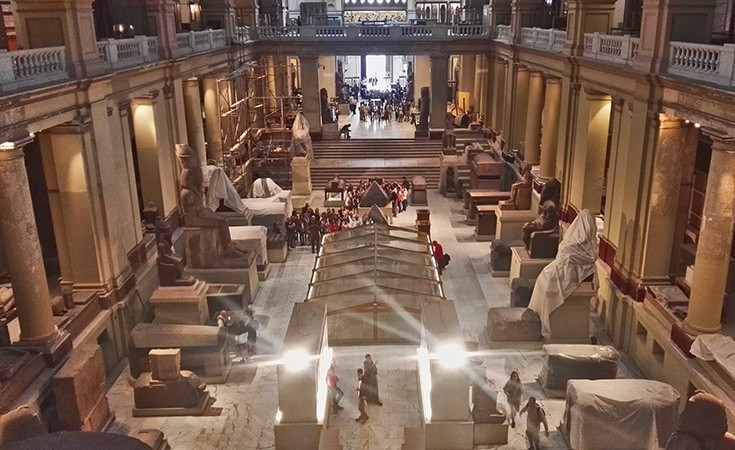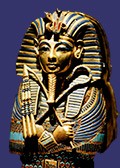
The Egyptian Museum in Cairo is a must-see for fans of Egyptian history since this museum offers the most complete exhibition of archaeological findings (more than 130,000 works of art dating mostly from the Pharaonic era) dating back to ancient Egypt. Visitors will be amazed by the hall of the Mummies and, in particular, the area dedicated to the treasures of Tutankhamun, with its famous still intact funerary mask (probably the most famous symbol of Egypt in the world).
In the ground floor, arranged in chronological order, the works from the Old Kingdom to the Greek-Roman age, passing through the Middle and the New Kingdom, are exhibited.
The first floor, on the other hand, which can be reached via a large staircase, is organized into thematic areas. The most famous parts are the room of the Mummies and the one dedicated to Tutankhamun's treasures found in his burial chamber.
What you should not miss in the Egyptian Museum?
 Tutankhamun's funerary mask
Tutankhamun's funerary mask
This mask represents one of the most famous works of art in the world. It was discovered by a British Egyptologist in the Pharaoh's burial chamber, in the Valley of the Kings, in Luxor. The mask highlights the isolated detail of the holes in the lobes, which, at that time, were reserved only for women and children. The headdress with the insignia of the cobra and the vulture symbolizes the power of the pharaoh. This mask is made of gold.
Tutankhamun as Nefertum
The head of Tutankhamun was found in the tomb of the pharaoh in the Valley of the Kings and it represents the young Tutankhamun as a child rising from a blue lotus flower and he is, therefore, associated with Nefertum, god of the rising Sun. The lobes are designed to accommodate the earrings.
Statuette of Cheops
This statuette is the only three-dimensional work of the Pharaoh that remained intact. It depicts Cheops sitting on a throne, holding a scepter in the shape of a scourge.
Khafra on the throne
The statue of the Pharaoh represents Khafra in his idealization of a divine figure, with a perfect body, well-defined and ageless muscles. Moreover, the complete absence of emotions or movement is supposed to represent the eternity of the pharaoh, as permanent as his rigid posture.
Isis, the mother of Thutmose III
The sculpture of the queen mother Isis was made for her son. Isis is portrayed in a classic pose of Egyptian art, that is, with her hands on her legs, a floral scepter in her left hand and a large wig on her head with braids of equal length.
Thuya funerary mask
Thuya was Tutankhamun's great-grandmother and her face on the mask is depicted with a light and graceful smile, bright eyes made from quartz and blue glass, with hints of red. Her heavy wig is held in place by a floral band.
The statue of Mentuhotep II
This sandstone sculpture represents the ancient Pharaoh Mentuhotep II, who played a very important role of being the one who carried out the great task of reuniting Egypt after the disintegration by inaugurating the Middle Kingdom. The statue is intact and depicts the pharaoh in the guise of the god Osiris, hence, the black color of the skin, typical for the god of the dead.
This is only a short list of the things that one may find in this museum. Many sculptures are colossal, many of them seem alive, since ancient Egyptians used precious stones as the eyes on the sculptures to make them look alive. Here visitors will also find all 5 golden sarcophagi of the Pharaoh Tutankhamun, along with all treasures that archeologists found in pharaoh’s burial chamber in Luxor. This is the only burial chamber that was untouched when it was discovered.
 Ticket price for the Egyptian Museum in Cairo
Ticket price for the Egyptian Museum in Cairo
The ticket price is 160 EGP per person.
Students will get a 50% discount but they must bring their student IDs with them.
(!) Photos made with a professional camera are not allowed. Visitors should purchase a ticket that allows them to take photos. Photos made with mobile phones are allowed.
(!) Taking photos in Tutankhamun’s room is not allowed.
 Working hours of the Egyptian Museum in Cairo
Working hours of the Egyptian Museum in Cairo
The Egyptian Museum in Cairo is open every day from 9 am to 7 pm.
During the period of Ramadan, museum could close at 5 pm.
(!) If visitors would like to avoid the crowd, they should visit the museum early in the morning.